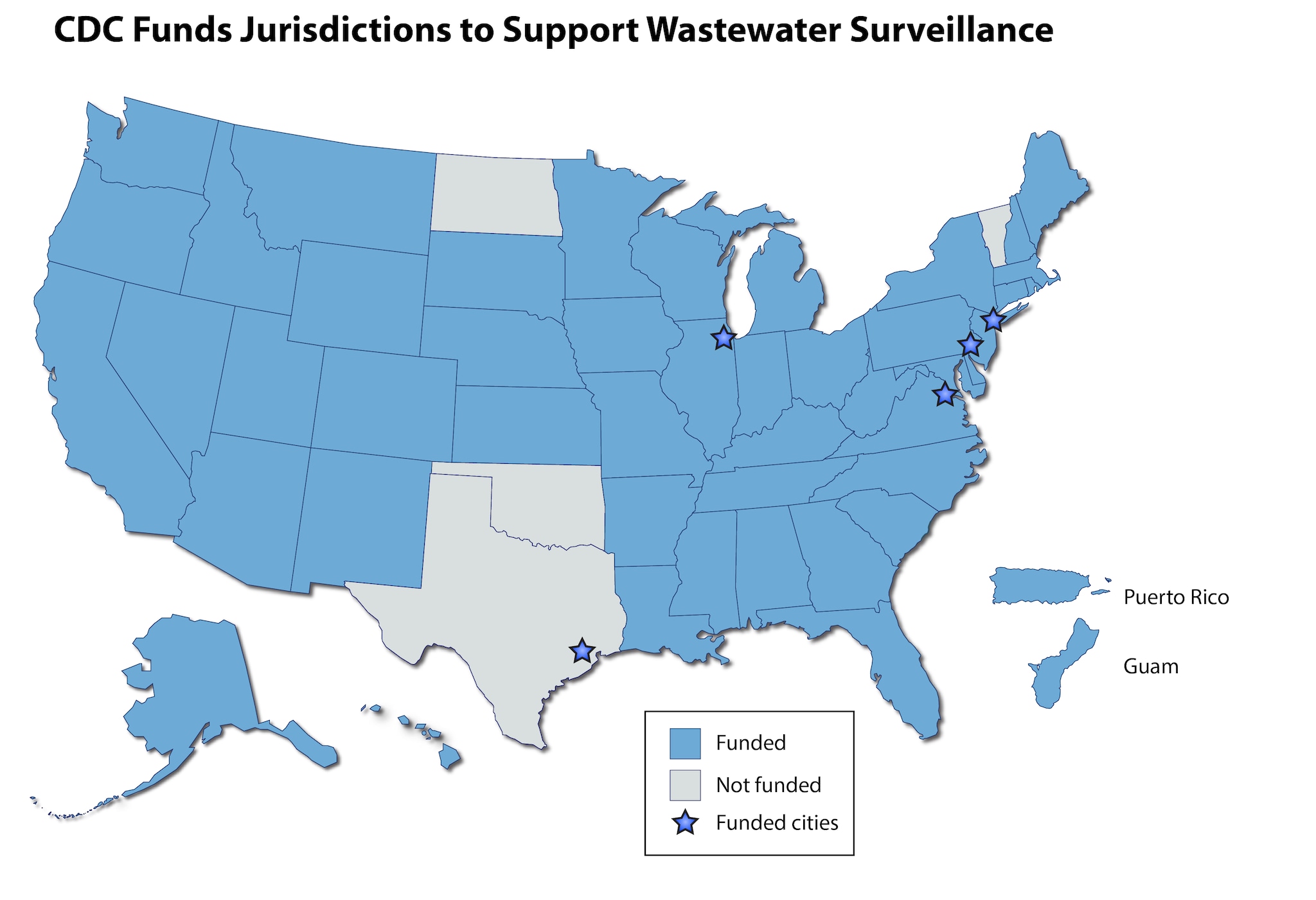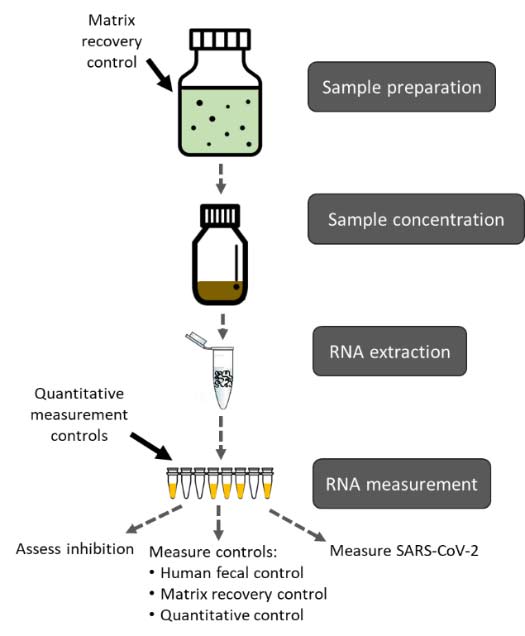What to know
SARS-CoV-2 enters wastewater through the stool of infected people. Wastewater testing is a novel approach for monitoring the virus. This surveillance data can provide an important early warning signal of increasing infections. CDC launched the National Wastewater Surveillance System (NWSS) in September 2020, and it now includes more than 1,200 testing sites nationwide.

Overview
Tracking the spread of SARS-CoV-2, the virus that causes COVID-19, continues to be vital to interrupting chains of transmission, preventing new cases of illness, and saving lives. Scientists can test community wastewater samples to detect the ribonucleic acid (RNA) of SARS-CoV-2. Wastewater testing is a novel approach for monitoring the virus, providing timely information about the changing prevalence of COVID-19 in different communities.
SARS-CoV-2 enters wastewater through the stool of infected people. Using genomic sequencing to monitor the concentration of SARS-CoV-2 in wastewater can detect the presence of infection in a community and suggest whether levels of infection are increasing or decreasing. When used as a complement to other surveillance methods, wastewater surveillance data can provide an important early warning signal of increasing infections. To assess whether further investigation is needed, public health officials can compare wastewater surveillance data to historic levels at the same site and among neighboring communities. Public health officials can also compare these data with trends in other surveillance systems, such as case reporting. Local circumstances, such as increased tourism or changes in prevention measures, are also considered to inform public health decisions.
In response to the COVID-19 pandemic, CDC launched the National Wastewater Surveillance System (NWSS) in September 2020 to coordinate and support the nation's capacity to monitor SARS-CoV-2 in wastewater. NWSS started as a grassroots effort to connect independent, local wastewater surveillance efforts to form a robust, sustainable national system. Through NWSS, health departments and public health laboratories develop their capacity to conduct wastewater surveillance, including epidemiology, data analytics, and laboratory support. This information can be a critical early warning for authorities of new outbreaks and inform local decision-making, such as where to have mobile testing and vaccination sites.
Since its launch, NWSS has made great strides and now includes more than 1,200 testing sites nationwide. As of July 2022, a total of 46 states, 5 cities, and 2 territories have wastewater surveillance systems in their communities, with samples collected from wastewater systems serving more than 130 million people in the United States. CDC scientists continue to provide technical guidance, data analysis, and access to data visualization to jurisdictions with wastewater surveillance systems.

Detecting variants in wastewater
Whole-genome sequencing (WGS) technology is used to decode the genetic information of infectious disease pathogens. Genomic sequencing supports public health in multiple areas, such as improving food safety, combating antimicrobial resistance, and detecting emerging infectious disease threats.
The sequencing of wastewater samples can provide valuable information about SARS-CoV-2 variants. While WGS cannot confirm the presence of any one specific variant in wastewater—because the virus's RNA breaks into pieces in wastewater—WGS of wastewater samples can detect pieces of variant-defining mutations, which can provide strong early evidence that a variant is likely present or may be spreading in the community before clinical case detection.
For example, a January 2022 MMWR article reports there was evidence of SARS-CoV-2 B.1.1.529 (Omicron) variant mutations in community wastewater in late November 2021, shortly before the Omicron variant had been identified in cases in these communities.

Wastewater surveillance at the local level
State, tribal, local, and territorial public health laboratories work closely with wastewater treatment plants to establish wastewater surveillance sampling strategies. These strategies, which may be updated as scientific knowledge increases and public health needs change, include multiple testing methods and laboratory processes used to analyze SARS-CoV-2 in wastewater and balance available resources and testing capacity with public health data needs.
A case study in the COVID-19 Genomic Epidemiology Toolkit describes the early detection of SARS-CoV-2 RNA in the wastewater system of Burlington, Vermont. Wastewater surveillance provided the city of Burlington and the state of Vermont with an additional layer of COVID-19 surveillance beyond diagnostic testing. Rapid wastewater testing allowed local health officials to deploy resources to areas with higher virus levels and provide specific warnings to the public, focusing on vulnerable populations.
The Delaware Public Health Laboratory has worked to implement wastewater surveillance testing since August 2020. To date, 12 of the 18 wastewater treatment plants in Delaware are using a surveillance system which has helped the state fill data gaps for areas where clinical testing and surveillance may be limited, including in underserved communities with limited access to testing sites. Delaware plans to expand on these investments to look for other pathogens in wastewater, such as norovirus, influenza, respiratory syncytial virus (RSV), and antimicrobial-resistant pathogens.

The future of wastewater surveillance
CDC will continue to expand NWSS to better understand and respond to infectious disease threats like antimicrobial resistance or foodborne diseases. Through an annual Epidemiology and Laboratory Capacity for Prevention and Control of Emerging Infectious Diseases (ELC) funding opportunity, NWSS resources are available to public health departments to develop wastewater surveillance programs. NWSS has established NWSS Centers of Excellence to support the continued development of wastewater surveillance for public health.
Public health laboratories across the nation are critical to our public health infrastructure. The use of innovative applications of sequencing and other AMD technologies will help prepare communities to detect and track disease outbreaks now and in the future.
Key public health advantages of wastewater surveillance include:
- The ability to identify changing infection trends for SARS-CoV-2, on average showing changes 4 to 6 days before those same changes in trends are seen in clinical cases.
- Cost-and time-efficiencies.
- No dependence on availability of COVID-19 testing, and no limitations caused by only sampling people with access to healthcare or people seeking healthcare when sick.
- Feasibility for implementation in many communities since nearly 80 percent of U.S. households are served by sewer systems.
Challenges of wastewater surveillance include:
- Potential exclusion of communities without sewer systems, such as those that rely on septic-based systems.
- Potential exclusion of communities or facilities served by decentralized wastewater systems, such as some prisons, universities, or hospitals that treat their own wastewater.
- Limitations on detecting low levels of the virus in a community.
